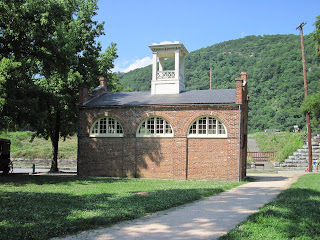
Today we traveled from Rockville and crossed into West Virginia en route to Harper's Ferry (aka Shenandoah Falls at Mr. Harper's Ferry).

From the Bolivar Heights battlefield at Harper's Ferry, this is a view of the three blue ridge mountains at the junction of three states. The hill on the left is in Maryland, the middle one is in Virginia, and the hill on the right is in West Virginia. At the base of these hills is the confluence of the Shenandoah and Potomac rivers.
It is easy to see why there would have been such geographic importance to this location during the Civil War. Basically, this was the last "speed bump" between Lee's Confederate Army and Washington, D.C. In addition, the town of Harper's Ferry housed a union armory and weapons manufacturing facility. The armory contained well over 100,000 rifles.
This was a conflicted area during the Civil War. Many Virginians were sympathetic to the Confederacy, and yet Harper's Ferry and its armory belonged to the federal government. An ill-trained and ill-equipped Union Army lost a battle to Stonewall Jackson and the Confederacy involving 23,000 soldiers here, but not before they attempted to destroy the armory and its equipment.
The good people of the town saw their livelihood being destroyed, and put out the fires, thus preserving much equipment for the Confederacy, which promptly moved it all to Richmond.
John Brown's efforts were not helpful in preventing the conflict.

A radical revolutionary, John Brown was a crusader who was bent on freeing the slaves. He helped escaping slaves and even armed them in Harper's Ferry. He knew about the armory, and wanted to raid the cache in order to facilitate a slave uprising across the South. He was captured by union troops, led by one Lieutenant Colonel Robert E. Lee, and hung in nearby Charles Town. Even today, the town remains split on whether John Brown was a hero or a villain. But everyone agrees that, much like our generation's 9-11, Brown's raid was a catalyst for the Civil War.
The arms industry contributed some major innovations in Harper's Ferry. An arms manufacturer named John Hall invented a breach-loading rifle, which made the old muskets obsolete. He also pioneered interchangeable rifle parts 100 years before Henry Ford, which facilitated field repairs.


After the battlefield, we moved down to the town of Harper's Ferry. We really needed more time (about 5 hours would be better).
On the rocky face above Harper's Ferry, Ian spotted this strange square (right). We took a picture, and discovered it was an advertisement for talcum powder (left), circa 1898. Must have been an early billboard!
Sherry found this artist hawking his paintings and signing these picture books with his prints. His wife says they are going to Gettysburg tomorrow, so maybe we'll take a second look.

After Harper's Ferry, we headed up the road about 10 miles to Antietam (pronounced AntEEtum). Our road was a curvy, hilly two lane road that tickled the boys' stomachs numerous times.
Antietam was the site of Lee's first major attempt to break the union strength. It bogged down into a battle of attrition. McClellan (Union) made three major attempts to break the Confederate lines. Ultimately, Lee withdrew, and McClellan, with superior numbers, failed to press his advantage. If he had, Gettysburg might not have happened ten months later.
On the other hand, if Lee had won at Antietam, the Confederates were likely to receive support from Europe, and would have had access to Northern railroads and supply lines.

This is a picture the boys took from the top of an observation tower. The split rail fences demark the southern flank of the battlefield, known as "Bloody Lane." This row was filled with the dead and dying at Antietam in a repeated attempts to control the line.
In a 3-hour cornfield skirmish on the north side of the battlefield, the Louisiana regiment lost 60% of their fighting forces in 30 minutes.

Here is a picture of the boys in the observation tower. They came down and gave me the camera, then climbed back up for their picture. Oh, to be young again!

Here is a picture of the boys in the observation tower. They came down and gave me the camera, then climbed back up for their picture. Oh, to be young again!

We left Antietam and entered Pennsylvania, arriving in Gettysburg around 8:00. A tourbus arrived at the same time, and Forrest was chatting with one of the tourists when the tourist said, "What year was that?" At that point, Forrest realized he was wearing his 1995 Rose Bowl t-shirt, featuring UO vs. Penn St. How appropriate.

